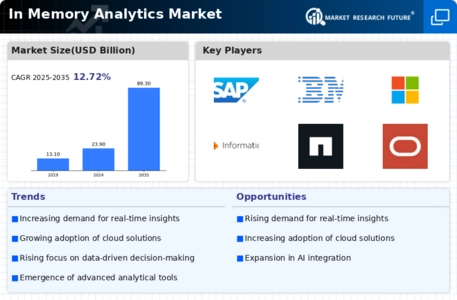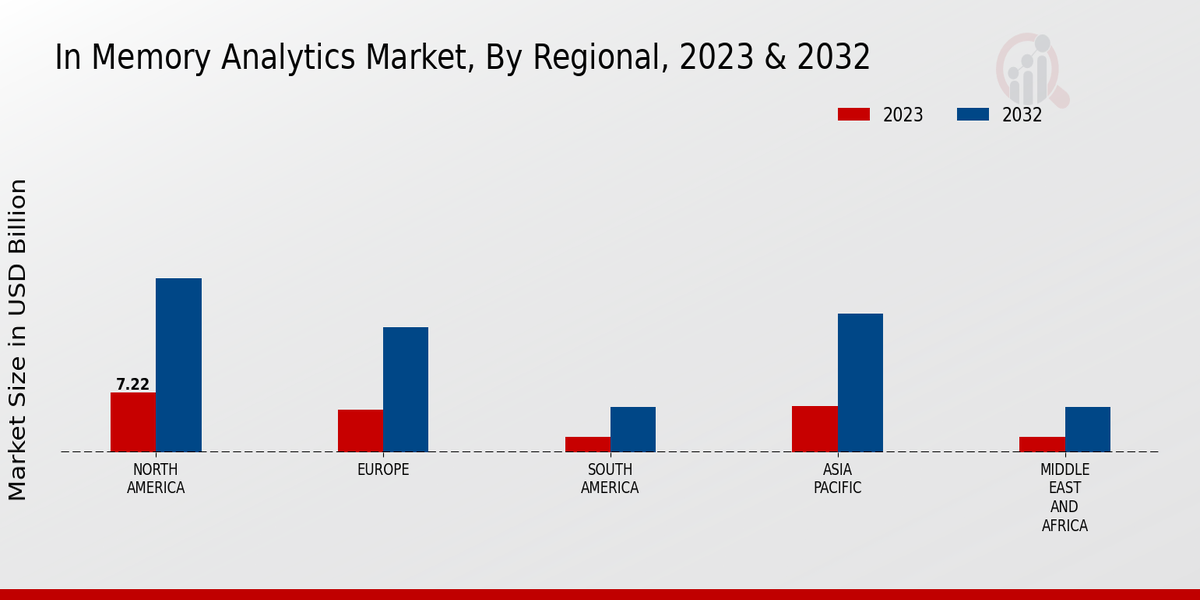Market Growth Projections
The Global In Memory Analytics Market Industry is poised for substantial growth, with projections indicating a market value of 23.9 USD Billion in 2024 and an anticipated increase to 89.3 USD Billion by 2035. This growth trajectory suggests a compound annual growth rate of 12.72% from 2025 to 2035, reflecting the increasing reliance on in-memory analytics across various sectors. The market's expansion is driven by factors such as the demand for real-time data processing, advancements in cloud computing, and the rising adoption of big data technologies. These dynamics collectively position the in-memory analytics market as a critical component of modern data strategies.
Advancements in Cloud Computing
The Global In Memory Analytics Market Industry benefits significantly from advancements in cloud computing technologies. The proliferation of cloud services enables organizations to deploy in-memory analytics solutions without the need for extensive on-premises infrastructure. This flexibility allows businesses of all sizes to leverage powerful analytics tools, driving market growth. As cloud adoption accelerates, the market is expected to expand, with projections indicating a value of 89.3 USD Billion by 2035. The ability to access and analyze data from anywhere enhances collaboration and supports data-driven decision-making across global enterprises.
Increased Focus on Customer Experience
The Global In Memory Analytics Market Industry is influenced by an increased focus on enhancing customer experience. Companies recognize that understanding customer behavior and preferences is essential for maintaining a competitive edge. In-memory analytics allows organizations to analyze customer data in real time, enabling personalized marketing strategies and improved service delivery. As businesses strive to create more engaging customer interactions, the demand for in-memory analytics solutions is likely to rise. This trend is expected to contribute to the overall growth of the market, as companies seek to leverage data for better customer insights.
Rising Adoption of Big Data Technologies
The Global In Memory Analytics Market Industry is closely intertwined with the rising adoption of big data technologies. Organizations are increasingly generating and collecting vast amounts of data, necessitating advanced analytics solutions to extract meaningful insights. In-memory analytics provides the speed and efficiency required to process big data, making it an attractive option for businesses. As the market evolves, it is anticipated to grow at a compound annual growth rate of 12.72% from 2025 to 2035. This growth underscores the critical role of in-memory analytics in harnessing the potential of big data across various industries.
Regulatory Compliance and Data Governance
The Global In Memory Analytics Market Industry faces growing pressure from regulatory compliance and data governance requirements. Organizations must ensure that their data practices align with various regulations, necessitating robust analytics solutions to monitor and manage data effectively. In-memory analytics provides the tools needed to maintain compliance while enabling organizations to derive insights from their data. As regulatory frameworks evolve, the demand for in-memory analytics solutions that support compliance efforts is likely to increase. This trend highlights the importance of integrating analytics into data governance strategies to mitigate risks and enhance operational transparency.
Growing Demand for Real-Time Data Processing
The Global In Memory Analytics Market Industry experiences a surge in demand for real-time data processing capabilities. Organizations increasingly rely on immediate insights to enhance decision-making and operational efficiency. This trend is particularly evident in sectors such as finance and retail, where timely data can lead to competitive advantages. The market is projected to reach 23.9 USD Billion in 2024, reflecting a robust appetite for solutions that facilitate rapid data analysis. As businesses continue to embrace digital transformation, the need for in-memory analytics solutions that can handle vast amounts of data in real time becomes paramount.













